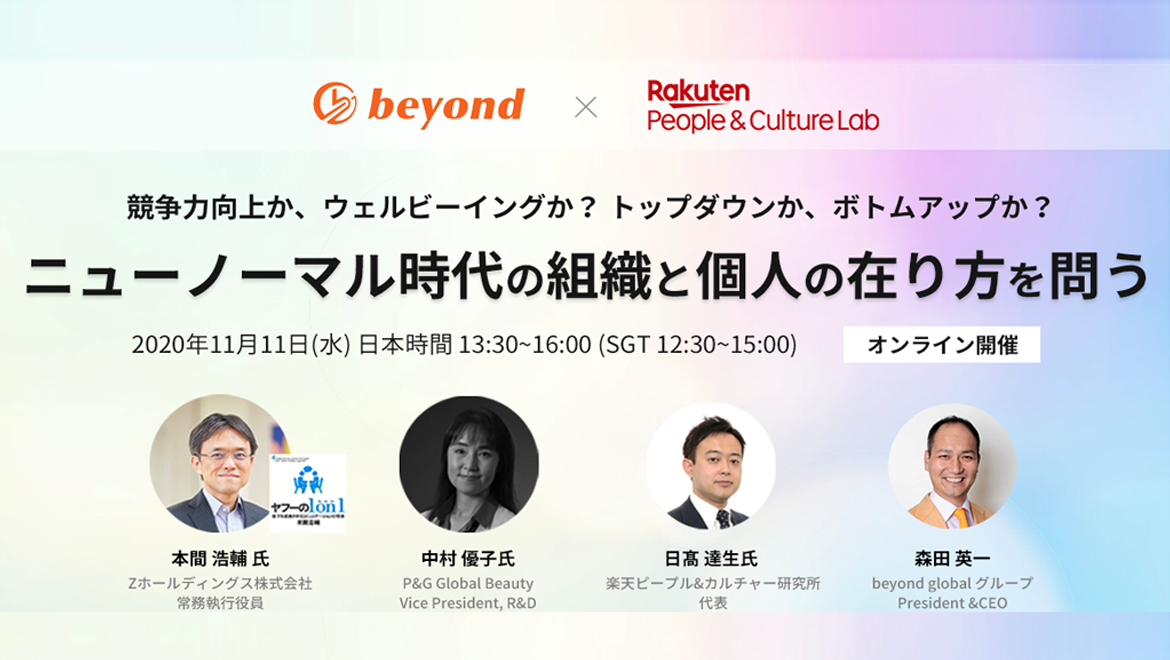This is the first part of a two-part review of the thought-provoking discussion that took place during “Questioning what’s best for individuals and organizations in the New Normal era,” a joint webinar that was held with beyond global in November 2020.
You can find an overview of the webinar (in Japanese) here.
Panelists: Kosuke Homma (Z Holdings Corporation), Yuko Nakamura (Procter & Gamble), Eiichi Morita (beyond global group), Tatsuo Hidaka (Rakuten People & Culture Lab)
Initiatives by guest panelists’ companies (examples)
Guest panelists Mr. Homma of Z Holdings and Ms. Nakamura of Proctor & Gamble (P&G) shared some of the characteristic initiatives that their companies are engaged in.
Mr. Homma: Mr. Homma discussed the establishment of the Chief Conditioning Officer position and the “anywhere office” policy (as initiatives introduced at Yahoo).
In the world of professional sports, a difference of just a few percentage points can determine whether an athlete fails to make the team or becomes a 100-million-yen player. But in the business world, even if you aren’t at your best, if you come to work, you can get paid. As a business professional, this isn’t acceptable, so I established the position of Chief Conditioning Officer (CCO), who is responsible for encouraging everyone to maintain good physical and mental health.
The “anywhere office” is one facet of the CCO-related promotion policies and allows each person to select the place where he or she can work most efficiently. It encourages individuals to choose the place that lets them autonomously boost their performance.
Ms. Nakamura: Innovation cannot be created unless employees are healthy, which is why we thoroughly believe that employee wellness is a manager’s responsibility.
The importance of taking a long-term perspective is something that is shared within the company and employee wellness is the responsibility of managers. Accordingly, we ask employees if the company and their immediate supervisors are supporting their work-life balance, and if they have sufficient energy left over after work, and these results are presented as scorecards for managers.Even if a department achieves a temporary improvement in results, if the employees are exhausted, when it comes time for internal transfers, other employees will not be willing to work there so, in the medium to long term, it will be considered an unhealthy organization. There have been instances when the managers of such departments have been issued an admonishment to remedy the situation.
Yahoo’s CCO could truly be considered a key position in the promotion of well-being. Also, at P&G, supporting the well-being of members is integrated into the job of all managers. These are excellent examples of creative role design aimed at improving well-being.
Remote work and productivity
This discussion focused on the changes in the way we work amid the coronavirus crisis. Please notice the thinking that provides the foundation for each company’s approach.
―Mr. Morita: Remote work and productivity … was there any apprehension on the front lines about whether or not subordinates would take advantage of remote work to neglect their responsibilities?
Ms. Nakamura: At P&G, work is completely-performance based. What each person does is different and managers do not strictly manage these tasks.
If a high-performance remote worker does the work of 10 people in one hour and then takes a nap, that poses no problem for the company. Rather, we encourage taking power naps. I have a problem with the thinking that views not focusing on your work as bad. For example, compared with a researcher who produces results after 10 experiments, the researcher who achieves the same or better results more efficiently, after three experiments, is the one who deserves a higher evaluation.
―Mr. Morita: Have there been any changes in working styles due to the COVID-19 pandemic?
Mr. Homma: Yes. Regardless of the coronavirus, making workers happier is an extension of the initiatives that have been carried out since the introduction of work-style reforms. I recognize the COVID-19 pandemic as marking a focus point for companies that led them to take the plunge and change working styles, accelerating a trend that had already been set in motion.
Ms. Nakamura: We were originally working from home once a week but during the lockdown, it became 100 percent remote work, which proved challenging. We were hearing a lot of feedback about how working solely from home was leading to overconcentration, how the home environment was ill-suited for work, and about the stress resulting from not being able to go out or meet with people.
Also, because employees were saving their paid vacation until conditions improved, we realized that, as of the end of August, some 80 percent of employees had not taken more than three consecutive days of paid leave, so had not been able to recharge.
In response, based on the thinking reflected in the following three points, we have recently been encouraging employees to come to the office with a target of 50 percent. Many of them have told us that they enjoy seeing everyone.
- How should we address the problem of a decreasing sense of belonging to the company and feelings of stress among employees (maintaining a performance-based approach while preserving a degree of freedom)?
- Fortuitous communication is particularly vital for innovation and research.
- It is hard for new employees to develop if they are not able to meet people.
In order to create an environment that makes it fun to come to the office, we’ve introduced such measures as a photo contest for beautiful scenery of the office, free delicious ice cream in the afternoons, and a competition using pedometers to determine who can walk the most steps. As a result, at present (as of November), around 70% of employees are coming to the office.
Grasping the status of employees and clarifying judgment criteria: these two aspects formed the basis for numerous suggestions aimed at ensuring the well-being of employees through the taking of prompt measures.

